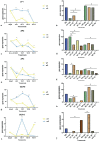The Effect of Different Doses of Melatonin on in Vitro Maturation of Human Follicular Fluid-Derived Oocyte-Like Cells
- PMID: 34786903
- PMCID: PMC9118972
- DOI: 10.5935/1518-0557.20210086
The Effect of Different Doses of Melatonin on in Vitro Maturation of Human Follicular Fluid-Derived Oocyte-Like Cells
Abstract
Objective: Human follicular fluid (FF) contains different cell populations including mesenchymal stem cells. Studies tried to improve their differentiation to oocyte and use them in infertility treatments. Using an antioxidant may improve the quality of these cells. The present study investigated the effects of different doses of melatonin on FF-derived cells grown to oocyte-like cells (OLC).
Methods: Cell viability (MTT assay), flow cytometry, and ICC staining were utilized to evaluate CD105 and CD34 expression; colony forming unit assay (CFU-F) capability, qRT-PCR were used to investigate ZP1, ZP2, ZP3, GDF9, and SCP3 expression. AMH, Estradiol and Progesterone levels in the supernatant were measured. Morphological characteristics of fibroblast-like cells changing to a round shape were seen specifically in the group treated with melatonin 10-7M after 2 weeks.
Results: There was no difference between control and treatment groups for MTT and CFU assays. ICC staining was positive for CD105 marker and negative for CD34 hematopoietic stem cell marker. qRT-PCR results indicated that ZP1, ZP2, GDF9, and SCP3 expression increased in the group treated with melatonin 10-7M in Week 2, while ZP3 decreased in this group. Progesterone and AMH were detected in differentiation medium.
Conclusions: Melatonin may improve in vitro formation of OLCs.
Keywords: Follicular fluid; infertility; melatonin; oocyte like cell; stem cell.
Figures








Similar articles
-
The Effect of Normal Follicular Fluid on the Differentiation of PCOS Ovarian Stem Cells into Oocyte-Like Cells.Adv Biomed Res. 2023 Nov 29;12:259. doi: 10.4103/abr.abr_151_23. eCollection 2023. Adv Biomed Res. 2023. PMID: 38192893 Free PMC article.
-
Bone morphogenetic protein 15 induces differentiation of mesenchymal stem cells derived from human follicular fluid to oocyte-like cell.Cell Biol Int. 2021 Jan;45(1):127-139. doi: 10.1002/cbin.11475. Epub 2020 Oct 10. Cell Biol Int. 2021. PMID: 32997425
-
BMP15 gene is activated during human amniotic fluid stem cell differentiation into oocyte-like cells.DNA Cell Biol. 2012 Jul;31(7):1198-204. doi: 10.1089/dna.2011.1396. Epub 2012 Feb 22. DNA Cell Biol. 2012. PMID: 22356426
-
Evaluating differentiation potential of the human menstrual blood-derived stem cells from infertile women into oocyte-like cells.Reprod Biol. 2021 Mar;21(1):100477. doi: 10.1016/j.repbio.2020.100477. Epub 2021 Jan 2. Reprod Biol. 2021. PMID: 33401233
-
Does supplementation of in-vitro culture medium with melatonin improve IVF outcome in PCOS?Reprod Biomed Online. 2013 Jan;26(1):22-9. doi: 10.1016/j.rbmo.2012.10.007. Epub 2012 Oct 12. Reprod Biomed Online. 2013. PMID: 23177415 Clinical Trial.
Cited by
-
Evaluation of the expression level of microRNA-21, microRNA-15a, microRNA-372 in human follicular fluid stem cells-derived oocyte-like cells (OLCs).JBRA Assist Reprod. 2024 Jun 1;28(2):289-294. doi: 10.5935/1518-0557.20240019. JBRA Assist Reprod. 2024. PMID: 38530760 Free PMC article.
-
The Effect of Normal Follicular Fluid on the Differentiation of PCOS Ovarian Stem Cells into Oocyte-Like Cells.Adv Biomed Res. 2023 Nov 29;12:259. doi: 10.4103/abr.abr_151_23. eCollection 2023. Adv Biomed Res. 2023. PMID: 38192893 Free PMC article.
References
-
- Alizadeh R, Bagher Z, Kamrava SK, Falah M, Ghasemi Hamidabadi H, Eskandarian Boroujeni M, Mohammadi F, Khodaverdi S, Zare-Sadeghi A, Olya A, Komeili A. Differentiation of human mesenchymal stem cells (MSC) to dopaminergic neurons: A comparison between Wharton's Jelly and olfactory mucosa as sources of MSCs. J Chem Neuroanat. 2019;96:126–133. doi: 10.1016/j.jchemneu.2019.01.003. - DOI - PubMed
-
- Almeida AP, Saraiva MVA, Araújo VR, Magalhães DM, Duarte ABG, Frota IMA, Lopes CAP, Campello CC, Silva JRV, Figueiredo JR. Expression of growth and differentiation factor 9 (GDF-9) and its effect on the in vitro culture of caprine preantral ovarian follicles. Small Rumin Res. 2011;100:169–176. doi: 10.1016/j.smallrumres.2011.06.001. - DOI
Publication types
MeSH terms
Substances
LinkOut - more resources
Full Text Sources

